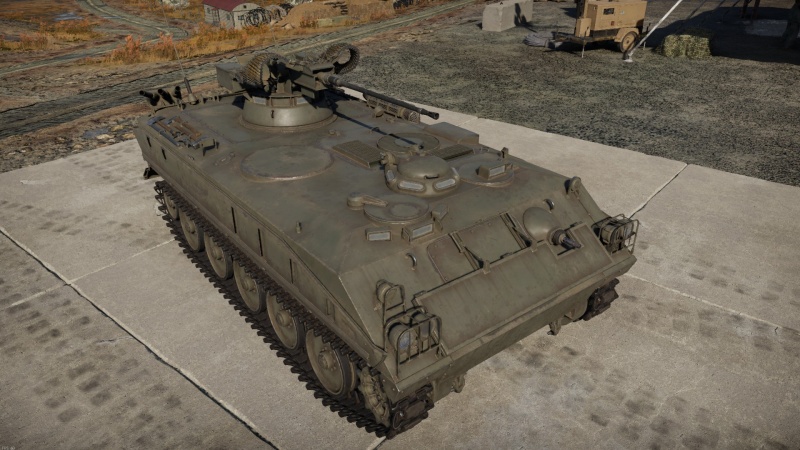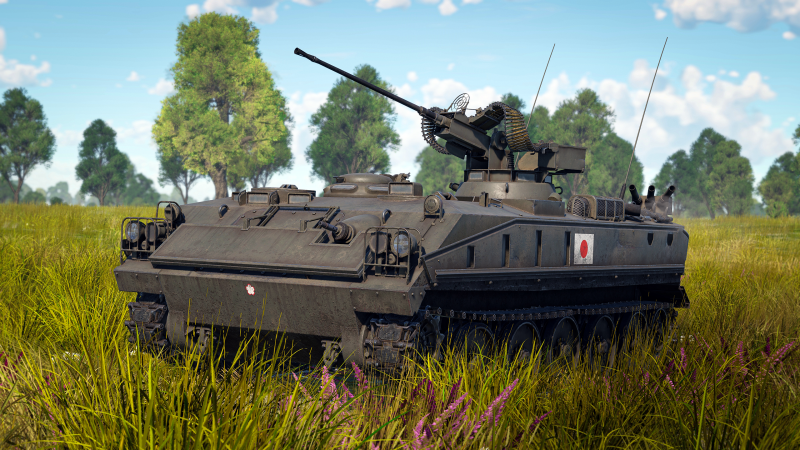Difference between revisions of "SUB-I-II"
(Updated Pros and Cons, History, and See Also) (Tag: Visual edit) |
m (→External links: Manufacturer) |
||
| (2 intermediate revisions by the same user not shown) | |||
| Line 165: | Line 165: | ||
* [[AMX-10P]] | * [[AMX-10P]] | ||
* [[Marder A1-]] | * [[Marder A1-]] | ||
| − | * [[ | + | * [[XM800T]] |
Vehicles with similar weapon systems | Vehicles with similar weapon systems | ||
* [[R3 T20 FA-HS]] | * [[R3 T20 FA-HS]] | ||
| + | * [[U-SH 204 GK]] | ||
| + | * [[Wiesel 1A4]] | ||
* [[Ystervark]] | * [[Ystervark]] | ||
* [[Type 87 RCV (P)]] | * [[Type 87 RCV (P)]] | ||
| Line 185: | Line 187: | ||
* [[wt:en/news/7997-development-sub-i-ii-speed-and-bite-en|[Devblog] SUB-I-II: Speed and Bite]] | * [[wt:en/news/7997-development-sub-i-ii-speed-and-bite-en|[Devblog] SUB-I-II: Speed and Bite]] | ||
| + | {{Manufacturer MHI}} | ||
{{Japan anti-aircraft vehicles}} | {{Japan anti-aircraft vehicles}} | ||
Latest revision as of 01:05, 26 June 2024
Contents
Description
The Mitsubishi SUB-I-II was a prototype for the Type 73 APC meant to replace the smaller Type 60 APC. Going through multiple prototypes, this particular version was tested with a Rh202 (20 mm) as a self-defense and anti-air cannon, though this armament would not see use in the final version.
It was introduced in Update "Apex Predators". The SUB-I-II provides an excellent fire rate with the possibility of an APDS belt in an amphibious yet squishy APC hull only offering up to 20 mm of armour. As such, if positioned correctly against a suitable target, the SUB-I-II can utilize the APDS autocannon to shred their opponent apart.
General info
Survivability and armour
The SUB-I-II has no notable armour. It is dangerous to stand in the open without cover, as the SPAA can be penetrated by any tank or plane. The turret is open topped which can allow for weapons of any type to damage the gunner. The survivability of this SPAA is very low if any enemy has a direct line of sight on it.
Armour type:
- Aluminium alloy 5083 (hull, gun mount)
- Cast homogeneous armour (cupola)
| Armour | Front (Slope angle) | Sides | Rear | Roof |
|---|---|---|---|---|
| Hull | 20 mm (52°) Upper glacis 20 mm (24-60°) Lower glacis |
12.7+5 mm Top 12.7 mm Bottom |
20 mm (7°) | 10 mm 5 mm Engine vents |
| Turret | 20 mm (conical) | 20 mm (conical) | 20 mm | |
| Cupola | 10 mm (spherical) Base 15 mm (spherical) Dome |
10 mm (spherical) Base 15 mm (spherical) Dome |
10 mm (spherical) Base 15 mm (spherical) Dome |
15 mm |
Notes:
- Suspension wheels and torsion bars are 10 mm thick, while tracks are 15 mm thick.
- Belly armour is 10 mm thick.
Mobility
The SUB-I-II has a modest top reverse speed in RB of -12 km/h so bear that in mind when choosing a good spot to shoot from.
| Game Mode | Max Speed (km/h) | Weight (tons) | Engine power (horsepower) | Power-to-weight ratio (hp/ton) | |||
|---|---|---|---|---|---|---|---|
| Forward | Reverse | Stock | Upgraded | Stock | Upgraded | ||
| Arcade | 65 | 17 | 13.5 | 497 | 668 | 36.81 | 49.48 |
| Realistic | 60 | 15 | 310 | 350 | 22.96 | 25.93 | |
Modifications and economy
Armaments
Main armament
| 20 mm Rh202 | Turret rotation speed (°/s) | Reloading rate (seconds) | ||||||||||||
|---|---|---|---|---|---|---|---|---|---|---|---|---|---|---|
| Mode | Capacity (Belt) | Fire rate | Vertical | Horizontal | Stabilizer | Stock | Upgraded | Full | Expert | Aced | Stock | Full | Expert | Aced |
| Arcade | 800 (100) | 800 | -10°/+80° | ±180° | - | 52.8 | 73.1 | 88.8 | 98.2 | 104.5 | 10.40 | 9.20 | 8.48 | 8.00 |
| Realistic | 35.7 | 42.0 | 51.0 | 56.4 | 60.0 | |||||||||
Ammunition
- Default: HVAP-T · HEFI-T
- DM51A1: HEFI-T · HEFI-T · HEFI-T · HVAP-T
- DM43: HVAP-T · HVAP-T · HVAP-T · HEFI-T
- DM63: APDS · APDS · APDS · HEFI-T
| Penetration statistics | |||||||
|---|---|---|---|---|---|---|---|
| Ammunition | Penetration @ 0° Angle of Attack (mm) | ||||||
| 10 m | 100 m | 500 m | 1,000 m | 1,500 m | 2,000 m | ||
| HVAP-T | 57 | 52 | 37 | 24 | 15 | 10 | |
| HEFI-T | 7 | 6 | 5 | 3 | 2 | 2 | |
| APDS | 66 | 61 | 45 | 31 | 21 | 14 | |
| Shell details | ||||||||||||
|---|---|---|---|---|---|---|---|---|---|---|---|---|
| Ammunition | Velocity (m/s) |
Projectile mass (kg) |
Fuse delay (m) |
Fuse sensitivity (mm) |
Explosive mass (TNT equivalent) (g) |
Ricochet | ||||||
| 0% | 50% | 100% | ||||||||||
| HVAP-T | 1,100 | 0.11 | - | - | - | 66° | 70° | 72° | ||||
| HEFI-T | 1,100 | 0.13 | 0.1 | 0.1 | 11.05 | 79° | 80° | 81° | ||||
| APDS | 1,150 | 0.13 | - | - | - | 75° | 78° | 80° | ||||
Ammo racks
| Full ammo |
1st rack empty |
2nd rack empty |
3rd rack empty |
4th rack empty |
5th rack empty |
6th rack empty |
Visual discrepancy |
|---|---|---|---|---|---|---|---|
| 8 | __ (+__) | __ (+__) | __ (+__) | __ (+__) | __ (+__) | __ (+__) | __ |
Machine guns
| 7.62 mm M1919A4 | ||||
|---|---|---|---|---|
| Mount | Capacity (Belt) | Fire rate | Vertical | Horizontal |
| Hull | 1,000 (250) | 500 | ±10° | ±10° |
Usage in battles
When hunting for planes, the SUB-I-II should always have some sort of cover to hide behind in case a plane retaliates. When shooting, you should also be mindful of the gun overheating and use all of the rounds in the belt as the SUB-I-II has only 800 rounds at most. If possible, try to remain near a friendly capture point to restock on ammo belts when they run out because the main cannon can shoot at 800 rpm.
Pros and cons
Pros:
- High rate of fire
- Can destroy most light vehicles and some medium vehicles through weak spots
- Excellent main weapon traverse angles for an APC
- Dual feed system can allow for quick switching of belts if ammunition is not fully expended
- Hull machine gun can be used to destroy unarmored targets, spot enemy vehicles, or knock down foliage
- Low profile hull
- Amphibious
Cons:
- Low survivability
- Open turret with exposed gunner
- Low ammo count
- Difficulty in damaging heavily armored targets
- Slow speed in water
- Engine turbine is loud and can give away the vehicle's position
History
Based on the influence of the Vietnam War as well as on the experiences from using the American M113 APC, the Japanese military concluded several drawbacks on their Type 60 APC. Namely, it was deemed that the vehicle had slightly poor mobility, lacked amphibious capabilities and had no NBC protection systems in place. As a result, in 1964 various Japanese companies, including Mitsubishi, began work on addressing some of these drawbacks by conducting tests with experimental platforms. By 1967, the Defense Agency laid out the requirements for a new APC design and contacted several companies to produce different parts of the vehicle.
Furthermore, four prototype versions were ordered for testing from Mitsubishi and Komatsu. Both companies had to produce a version with steel armor plating as well as one made from aluminum. While Mitsubishi’s aluminum-based prototype would in the end be selected as the most suitable design and would thus form the basis for the subsequent production version of the Type 73 APC, it was also selected to conduct different tests.
Namely, during testing, the SUB-I-II prototype, as it was known, also had a Rheinmetall 20mm turret mounted on its roof to test the feasibility of evolving the Type 73 from a pure APC into an IFV design. However, due to various technical issues and an increased cost, it was decided not to pursue this design choice further. As a result, the Type 73 would end up remaining a pure APC design, without substantial armament fitted to it.
Media
- Skins
See also
Vehicles of similar configuration
Vehicles with similar weapon systems
Vehicles derived from the Type 73 chassis
External links
| Japan anti-aircraft vehicles | |
|---|---|
| Ke-Ni Derivatives | Ta-Se · So-Ki |
| Wheeled | Type 94 |
| Tracked | SUB-I-II |
| Radar SPAAG | Type 87 |
| Missile SPAA | Type 93 · Type 81 (C) |
| USA | ▅M16 MGMC · ▅M19A1 · ▅M42 |






